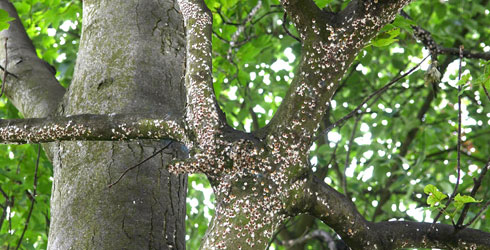Pulvinaria regalis
Scale insects are true bugs - members of the order Hemiptera whose species all feed on liquid food via modified tubular mouthparts called stylets.
Adult scale insects are very diverse in appearance but most females have reduced mobility, and some can only move about in the first larval stage - crawler.
The horse-chestnut scale belongs to the family Coccidae, which have ‘soft scales’ - the adult female is not protected by a cover or ‘test’.
All scale insects are phytophagous - they feed on plants by ingesting their sap. Some species are highly polyphagous, feeding on many different plants. Such species are notorious agricultural pests.
Pulvinaria regalis is an alien species introduced into Europe from Asia. It is broadly polyphagous and the insect has become extremely common in much of Britain, where it is noticeable on tree trunks.
Species detail
-

Distribution
Pulvinaria regalis was introduced into Europe from Asia accidentally. Find out where it likes to live.
-

Biology
The horse-chestnut scale secretes a white fluffy sac to lay its eggs in, and this makes it easy to spot on tree trunks. Find out more about this insect’s lifecycle.
-

Conservation
The horse-chestnut scale is an urban pest, but does not generally damage trees. Find out what can be done to control it.
-

References
Get more reference information on Pulvinaria regalis.
Images

Tree bough covered in Pulinaria regalis.

Single adult female Pulvinaria regalis prior to secretion of white ovisac.

Single adult female Pulvinaria regalis with her ovisac.

Female Pulvinaria regalis ovipositing on a non-host, a dandelion flower stem - this will die long before the crawlers have a chance to feed.

Huge infestation of adult female Pulvinaria regalis in the process of secreting their ovisacs.
Author's quote
"This particular scale insect is, in its own way, quite spectacular and often gives the entire trunk and main boughs of urban trees a curious mottled appearance because of the presence of thousands of ovisacs. Despite being so easily seen, and presumably arousing some curiosity amongst the public, few people know what is causing this strange phenomenon."
About the author
Dr Jon Martin
Former Curator of Hemiptera, Department of Entomology.
